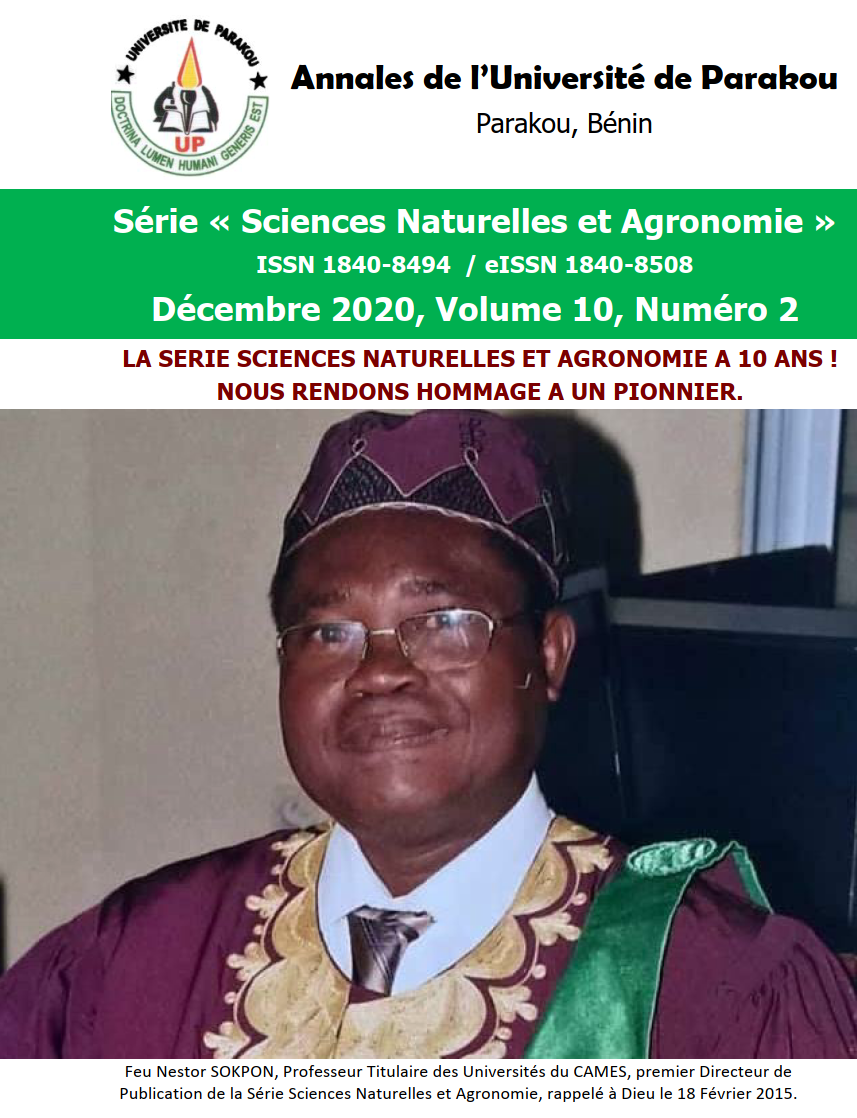Facteurs socio-économiques expliquant la déforestation et la dégradation des écosystèmes dans les domaines soudanien et soudano-guinéen du Bénin
DOI:
https://doi.org/10.56109/aup-sna.v10i2.36Keywords:
affectation des terres, perception, causes, dégradation, déforestationAbstract
Le changement d’affectation des terres est l’une des causes majeures de la dégradation et de la déforestation dans le monde. Au Bénin, les écosystèmes sont largement dépendants des activités anthropiques. Cette étude vise à analyser la perception de l’état des écosystèmes forestiers ainsi que des moteurs d’affectation des terres de déforestation et de dégradation afin de formuler des stratégies de gestion durable. Elle s’est basée sur une enquête auprès de 671 individus dans 66 villages de six communes repartis dans deux zones écologiques. Les caractéristiques socio-économiques, la perception de l’état et des moteurs de dégradation des écosystèmes forestiers ont été collectés. Après une analyse descriptive de la perception locale des moteurs de dégradation, la régression logistique binaire a été utilisée pour tester l’effet des facteurs socio-économiques sur la probabilité de citation d’une cause de dégradation et de déforestation. Les résultats montrent que la communauté locale a une large perception des moteurs de dégradation, incluant les facteurs directs et indirects. L’agriculture, l’élevage, l’exploitation forestière illégale, la démographie, l’urbanisation, la chasse et la pauvreté ont été perçus différemment et en fonction de la région écologique, du niveau d’instruction, de l’âge et de l’ethnie. La prise en compte de ces facteurs déterminants de la perception des moteurs de dégradation et de déforestation doit être considérée pour élaborer les programmes de développement durable et de gestion intégrée de l’environnement.
Downloads
Metrics
References
Adomou A. C., 2005. Vegetation patterns and environmental gradients in Benin Implications for biogeography and conservation. PhD thesis, Wageningen University, 150p
Ahmad N., Pandey P., 2018. Assessment and monitoring of land degradation using geospatial technology in Bathinda district, Punjab, India. 75–90. DOI: https://doi.org/10.5194/se-9-75-2018
Angelsen A., Kaimowitz D., 1999. Rethinking the Causes of Deforestation. World Bank Res Obs. 14: 73–98. DOI: https://doi.org/10.1093/wbro/14.1.73
Appiah M., Blay D., Damnyag L., Dwomoh F.K., 2009. Dependence on forest resources and tropical deforestation in Ghana. Environ Dev Sustain. 11: 471–87. https://doi.org/10.1007/s10668-007-9125-0 DOI: https://doi.org/10.1007/s10668-007-9125-0
Avakoudjo J., Mama A., Toko I., Kindomihou V., Sinsin B., 2014. Dynamique de l’occupation du sol dans le Parc National du W et sa périphérie au nord-ouest du Bénin. International Journal of Biological and chemical Sciences. 8(6): 2608–25. DOI: https://doi.org/10.4314/ijbcs.v8i6.22
Bah O.A., Kone T., Yaffa S., Ndiaye M.L., 2019. Land Use and Land Cover Dynamics in Central River Region of the Gambia, West Africa from 1984 to 2017. 5(2): 5–18. https://doi.org/10.11648/j.ajme.20190502.11 DOI: https://doi.org/10.11648/j.ajme.20190502.11
Bala G., Caldeira K., Wickett M., Phillips T., Lobell D., Delire C., Mirin A., 2007. Combined climate and carbon-cycle effects of large-scale deforestation. Proceedings of the National Academy of Sciences. 6550–5. DOI: https://doi.org/10.1073/pnas.0608998104
Biaou S., Houeto F., Gouwakinnou G., Honoré S.S., Awessou B., 2019. Dynamique spatio-temporelle de l’occupation du sol de la forêt classée de Ouénou-Bénou au Nord Bénin HAL Id : hal-02189367.
Borrego A., Skutsch M., 2019. How Socio-Economic Differences between Farmers Affect Forest Degradation in Western Mexico. Forestry. 10: 893. DOI: https://doi.org/10.3390/f10100893
Ciza S.K., Mikwa J., Malekezi A.C., Gond V., Bosela F.B., 2015. Identification des moteurs de déforestation dans la région d’Isangi, République démocratique du Congo. Bois et forêts des tropiques. 324(2): 29–38. https://doi.org/10.19182/bft2015.324.a31264 DOI: https://doi.org/10.19182/bft2015.324.a31264
Dagnelie P., 1998. Statistique théorique et appliquée volume 2. De Boeck et Larcier, Paris et Bruxelles.
Durand L., Lazos E., 2008. The Local Perception of Tropical Deforestation and its Relation to Conservation Policies in Los Tuxtlas Biosphere Reserve, Mexico. 383–94. https://doi.org/10.1007/s10745-008-9172-7 DOI: https://doi.org/10.1007/s10745-008-9172-7
FAO, 2018. La situation des forets du monde: les forêts au service du développement durable.
Fernández-Llamazares Á., Díaz-Reviriego I., Guèze M., Cabeza M., Pyhälä A., Reyes- García V., 2016. Local perceptions as a guide for the sustainable management ofnat- ural resources: empirical evidence from a small-scale society in Bolivian Amazonia. Ecol. Soc. 21(1): 2. DOI: https://doi.org/10.5751/ES-08092-210102
Gaoue O.G., Ticktin T., 2009. Fulani knowledge of the ecological impacts of Khaya senegalensis (Meliaceae) foliage harvest in Benin and its implications for sustainable harvest. Econ. Bot. 63: 256–270. DOI: https://doi.org/10.1007/s12231-009-9091-6
Geist H., Lambin E., 2001. What drives tropical deforestation? A meta-analysis of proximate and underlying causes of deforestation based on subnational case study evidence. Land-Use and Land-Cover Change (LUCC) Project.
Geistn H., Lambin E., 2002. Proximate causes and underlying driving forces of tropical deforestation. BioScience. 52: 143–150. DOI: https://doi.org/10.1641/0006-3568(2002)052[0143:PCAUDF]2.0.CO;2
Gbedahi L.O., C., Biaou S. S., H., Mama A., Gouwakinnou G.N., Soulémane N., 2019. Dynamique du couvert végétal à Bassila au nord Bénin pendant et après la mise en œuvre d’un projet d’aménagement forestier Dynamic of vegetation cover in Bassila in northern Benin before and after a forest management project. 13(February): 311–24. DOI: https://doi.org/10.4314/ijbcs.v13i1.25
Gibbs H.K., Ruesch A.S., Achard F., Clayton M.K., Holmgren P., Ramankutty N., Foley J.A., 2010. Tropical forests were the primary sources of new agricultural land in the 1980s and 1990s. Proceedings of the National Academy of Sciences of the United States OfAmerica. 16732–16737. DOI: https://doi.org/10.1073/pnas.0910275107
GIEC, 2007. Changements climatiques-Rapport de synthèse, Groupe d’experts intergouvernemental sur l’évolution du climat.
Hahn-Hadjali K. et A.T., 2000. Perception des espèces en voie de disparition en milieu gourmantché (Est du Burkina Faso). Berichte des Sonderforschungsbereichs. 268(14): 285–97.
Hamandawana H., Nkambwe M., Chanda R., Eckardt F., 2005. Population driven changes in land use in Zimbabwe’s district of Masvingo province: Some lessons from recent history. Appl. Geogr. 25: 248– 270. DOI: https://doi.org/10.1016/j.apgeog.2005.03.005
Hosonuma N., Herold M., Sy V. De, Fries R.S. De, 2012. An assessment of deforestation and forest degradation drivers in developing countries. https://doi.org/10.1088/1748-9326/7/4/044009 DOI: https://doi.org/10.1088/1748-9326/7/4/044009
Houéssou L.G., Tèka O., Imorou I.T., Lykke A.M., Sinsin B., 2013. Land use and land-cover change at W Biosphere Reserve and its surroundings areas in Benin Republic (West Africa). Environment and Natural Resources Research. 3(2): 87–101. DOI: https://doi.org/10.5539/enrr.v3n2p87
Imorou I.T., Arouna O., Zakari S., Djaouga M., Thomas O., Kinmadon G.,2019. Évaluation de la déforestation et de la dégradation des forêts dans les aires protégées et terroirs villageois du bassin cotonnier du Bénin INSAE, 2016. Cahier des villages et quartiers de ville du departement du borgou (rgph-4, 2013).
Islam M., Rahman S., Kabir A., Islam N., 2020. Remote Sensing Applications: Society and Environment Predictive assessment on landscape and coastal erosion of Bangladesh using geospatial techniques. Remote Sensing Applications: Society and Environment. 17(November 2019): 100277. https://doi.org/10.1016/j.rsase.2019.100277 DOI: https://doi.org/10.1016/j.rsase.2019.100277
Kindu M., Schneider T., Teketay T., Knoke T., 2015. Drivers of land use/land cover changes in Munessa- Shashemene landscape of the south-central highlands of Ethiopia. Environ. Monit. Assess. 187: ,452. DOI: https://doi.org/10.1007/s10661-015-4671-7
Kissinger G., Herold M., Veronique D.S., 2012. Drivers of Deforestation and Forest Degradation. A Synthesis Report for REDD+ Policymakers. Vancouver Canada.
Kodjovi A., Léonard M., Sêmihinva A., Béssan A.K., Amah A., Badabaté D., Koudzo K.D., Kokou A., 2019. Connaissances écologiques locales sur les indicateurs de dégradation des sols utilisées par les paysans dans la zone guinéenne du Togo (Afrique de l’ouest). Science de la vie, de la terre et agronomie. 07: 47–56.
Loureiro J., Campos A., Lima E. De, Gaoue O.G., Paulino U., 2018. Science of the Total Environment How can local representations of changes of the availability in natural resources assist in targeting conservation? Science of the Total Environment. 628–629: 642–9. https://doi.org/10.1016/j.scitotenv.2018.02.064 DOI: https://doi.org/10.1016/j.scitotenv.2018.02.064
Maddison D., 2007. The perception of and adaptation to climate change in Africa. Policy Research Working Paper. DOI: https://doi.org/10.1596/1813-9450-4308
Makunga J.E., Misana S.B., 2017. The Extent and Drivers of Deforestation and Forest Degradation in Masito-Ugalla Ecosystem, Kigoma Region, Tanzania. Open Journal of Forestry. 7: 285–305. https://doi.org/10.4236/ojf.2017.72018 DOI: https://doi.org/10.4236/ojf.2017.72018
Mama A., Sinsin B., Cannière C. De, Bogaert J., 2013. Anthropisation et dynamique des paysages en zone soudanienne au nord du Bénin. Tropicultura. 31(1): 78–88.
Mawenda J., Watanabe T., 2020. sustainability An Analysis of Urban Land Use / Land Cover Changes in Blantyre City , Southern Malawi ( 1994 – 2018 ). 1–18. DOI: https://doi.org/10.3390/su12062377
Mensah, S., Veldtman, R., Ephrem, A., Ham, C., Glèlè, R., Seifert, T., 2017. Ecosystem service importance and use vary with socio-environmental factors: A study from household-surveys in local communities of South Africa. Ecosystem Services 23, 1–8. https://doi.org/10.1016/j.ecoser.2016.10.018 DOI: https://doi.org/10.1016/j.ecoser.2016.10.018
Mouhamadou I.T., Imorou I.T., Mèdaho A.S., Sinsin B., 2013. Perceptions locales des déterminants de la fragmentation des îlots de forêts denses dans la région des Monts Kouffé au Bénin. Journal of Applied Biosciences. 66: 5049–59. https://doi.org/10.4314/jab.v66i0.95002 DOI: https://doi.org/10.4314/jab.v66i0.95002
Munthali M.G., Davis N., Adeola A.M., Botai J.O., Jonathan M., Chisale H.L.W., Orimoogunje O.O.I., 2019. Local Perception of Drivers of Land-Use and Land- Cover Change Dynamics across Dedza District, Central Malawi Region. Sustainability. 11: 1–25. https://doi.org/10.3390/su11030832 DOI: https://doi.org/10.3390/su11030832
Nyanda H.N., Kegamba J.J., Sangha K.K., 2018. Impacts of Land Cover Change on Conservation, a Linkage of Spatial Analysis and Anthropogenic Activities in Tanzania. 344–61. https://doi.org/10.4236/ojf.2018.83022 DOI: https://doi.org/10.4236/ojf.2018.83022
Obersteiner M., Huettner M.M., Kraxner F., McCallum I., Aoki K., Bottcher H., Fritz S., Gusti M., Havlik P., Kindermann G., Rametsteiner E., Reyers B., 2009. On fair, effective and efficient REDD mechanism design. Carbon Balance and Management. 4: 11. DOI: https://doi.org/10.1186/1750-0680-4-11
Olanrewaju R.M., Tilakasiri S.L., Bello F.B., 2018. Community perception of deforestation and climate change in Ibadan, Nigeria Community perception of deforestation and climate change in Ibadan, Nigeria. J. Univ. Ruhuna. 6(1): 26–36. https://doi.org/10.4038/jur.v6i1.7866 DOI: https://doi.org/10.4038/jur.v6i1.7866
Rutebuka E., Mwaru F., Asamoah E.F., Rukundo E., 2018. Quantitative of Ecosystem Services and Disservices Studies in the Tropics. Journal of Ecosystem & Ecography. 8: 258–69. https://doi.org/10.4172/2157-7625.1000258
Sambiéni K.R., Toyi M.S., Mama A., 2015. Perception paysanne sur la fragmentation du paysage de la Forêt classée de l’Ouémé Supérieur au nord du Bénin. [VertigO] La revue électronique en sciences de l’environnement. 15(2). DOI: https://doi.org/10.4000/vertigo.16477
Sánchez-cortés M.S., Lazos E., Silvia M., Lazos S.E., 2011. Indigenous perception of changes in climate variability and its relationship with agriculture in a Zoque community of Chiapas, Mexico. (August). https://doi.org/10.1007/s10584-010-9972-9 DOI: https://doi.org/10.1007/s10584-010-9972-9
Santilli M., Moutinho P., Schwartzman S., Nepstad D., Curran L.M., Nobre C., 2005. Tropical Deforestation and the Kyoto Protocol. Climate Change. 71: 267–276. DOI: https://doi.org/10.1007/s10584-005-8074-6
Sean M., Richard F., Thomas B., James W., 2016. Biodiversity: The ravages of guns, nets and bulldozers. Nature. 536(143). DOI: https://doi.org/10.1038/536143a
Su G.S., Macawile J., Villarino A., Agapito J., Gomez N., 2011. Recognizing Local People’ s Perceptions Towards Deforestation in Quezon. Enviromental Research Journal. 5(3): 131–5. https://doi.org/10.3923/erj.2011.131.135 DOI: https://doi.org/10.3923/erj.2011.131.135
Traoré L., Ouédraogo I., Ouédraogo A., Thiombiano A., 2011. Perceptions, usages et vulnérabilité des ressources végétales ligneuses. International Journal of Biological and chemical Sciences. 5(1): 258–78. DOI: https://doi.org/10.4314/ijbcs.v5i1.68103
Twongyirwe R., Bithell M., Richards K.S., 2018. Revisiting the drivers of deforestation in the tropics: Insights from local and key informant perceptions in western Uganda. Journal of Rural Studies. 63(August): 105–19. https://doi.org/10.1016/j.jrurstud.2018.08.013 DOI: https://doi.org/10.1016/j.jrurstud.2018.08.013
Van Khuc Q., Tran B.Q., Meyfroidt P., Paschke M.W., 2018. Drivers of deforestation and forest degradation in Vietnam: An exploratory analysis at the national level. Forest Policy and Economics. 90: 128–141. DOI: https://doi.org/10.1016/j.forpol.2018.02.004
Vodouhê F.G., Coulibaly O., Adégbidi A., Sinsin B., 2010. Forest Policy and Economics Community perception of biodiversity conservation within protected areas in Benin. 12: 505–12. https://doi.org/10.1016/j.forpol.2010.06.008 DOI: https://doi.org/10.1016/j.forpol.2010.06.008
White F., 1986. La Végétation de l’Afrique. Mémoire accompagnant la carte de végétation de l’Afrique/AETFAT/UNESCO. Paris, France.
Willock J., Deary I.J., Edwards-Jones G., Gibson G.J., McGregor M.J., Sutherland A., Dent J.B., Morgan O., Grieve R., 1999. The Role of Attitudes and Objectives in Farmer Decisionmaking: Business and Environmentally Oriented Behaviour in Scotland. Journal of Agricultural Economics. 50: 286–303. DOI: https://doi.org/10.1111/j.1477-9552.1999.tb00814.x
Zeb A., Hamann A., Armstrong G.W., Acuna-castellanos D., 2019. Forest Policy and Economics Identifying local actors of deforestation and forest degradation in the Kalasha valleys of Pakistan. Forest Policy and Economics. 104(March): 56–64. https://doi.org/10.1016/j.forpol.2019.04.005. DOI: https://doi.org/10.1016/j.forpol.2019.04.005
Downloads
Published
How to Cite
Issue
Section
Categories
License
Copyright (c) 2020 Fiacre Codjo AHONONGA, Gérard Nounagnon GOUWAKINNOU, Honoré BIAOU, Séverin BIAOU

This work is licensed under a Creative Commons Attribution 4.0 International License.













